I like a clean coop, and the reasons for that are numerous. There are the health benefits: removal of manure reduces the likelihood of internal parasites, controls flies and noxious odors, and provides the birds with dry, fresh air that keeps their respiratory tracts healthy. Removal of dust and cobwebs reduces the germ load in the barn. But, even without those reasons, I’d keep the coops clean because tidy and sweet-smelling enclosures with active, content, animals within makes me happy.
During the week, my barn chores take little time. I let the hens out in the morning, and let close them back in at night. I check water and feed. I use a kitty litter scoop to pick up any obvious messes (when you have a broody hen that leaves broody poop, you’ll want to do that!) Once a week, usually on the weekend, but it varies depending on my calendar (chickens are not the sort of animals that demand an exact schedule of their caregivers) I do a thorough coop cleaning, and clean the goats’ area.
This is what I do:
First, I let the hens out to free-range. It’s much easier to tidy up when they’re not underfoot.
I’m careful to keep Phoebe in. She checks where everyone has gone to.
Buffy gets carried onto the lawn and set into a warm patch of sun.
The goats get closed out of their stall, otherwise they will “help.” Have you ever tried to wield a shovel and bucket around a goat? Unless you’re a comedienne developing a slapstick routine, I suggest you don’t.
Although the goat stall doesn’t look too bad,
it does need shoveling up and airing out.
I also sweep and shovel up the manure that piles up in their outdoor pen. All of their used shavings and waste goes into the compost in the chicken run. The hens like scratching through it. The two species don’t share internal parasites, and the hens will eat up any nasty bugs found in the goats’ manure, so this is a practical way to turn the manure into useful compost for the garden.
Next, I go into the Gem’s area. Chickens poop a lot at night while they are sleeping, and so the bulk of their manure ends up under the roosts.
I use a fine-tined pitchfork to get it up.
That manure goes into a compost bin where the hens can’t get into it. This helps to control their internal parasites, as removing manure breaks the lifecycle of those pests. Eventually this will break down into lovely dirt and be used in my garden.
Chickens are continually scratching and shredding – food, bedding, manure. It becomes a fine dust that covers everything. It will accumulate under the pine shavings, looking like a layer of sand. A few times a year I shovel everything up and start fresh. I’ll be doing that soon, but not until the hens finish molting, so that I can get rid of the piles of feathers, too. But, every week I sweep the walls, sills and beams in the barn.
Look at the dust in the air!
I don’t do a vigorous sweeping every week, but when I do, I wear a mask. I don’t want to breathe those fine particulates in.
I top off the feeders.
I scrub the waterer.
I rake the pen.
This is a job well done.
These tasks are repeated in the Little Barn. When bedding gets low, I add fresh pine shavings. Love that smell!
Once all is clean, I call the hens back into their runs. By now the goat stall has aired out. I add fresh bedding, and put a little hay in the manger, after all, this entire cleaning routine took about an hour. The goats were starving.
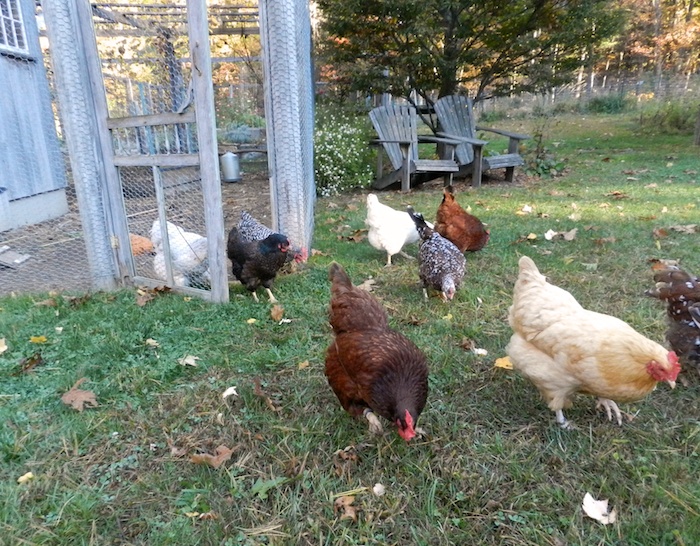
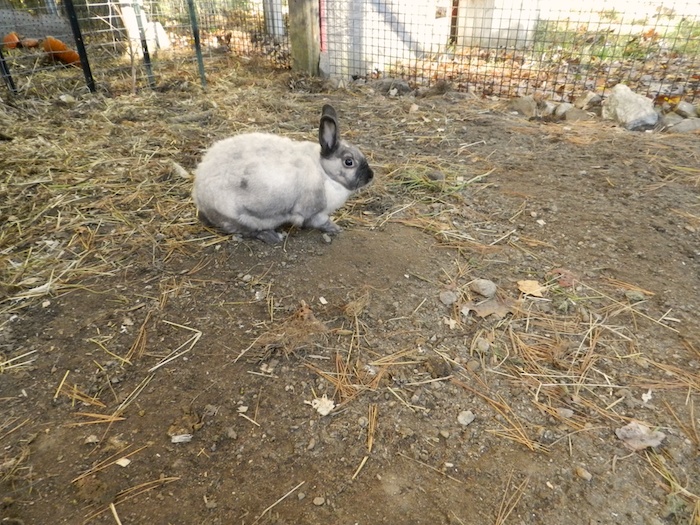

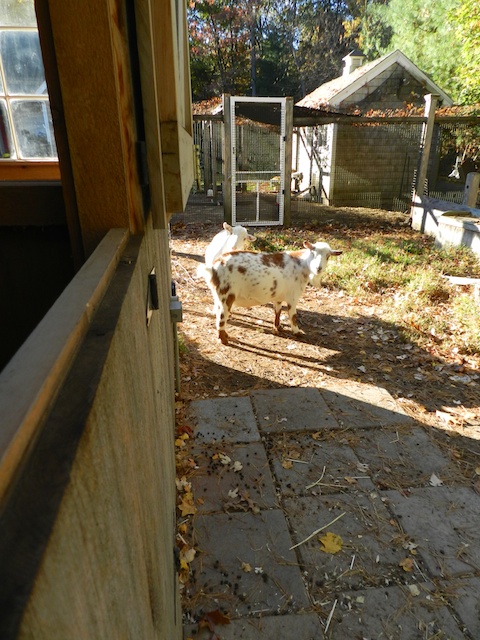
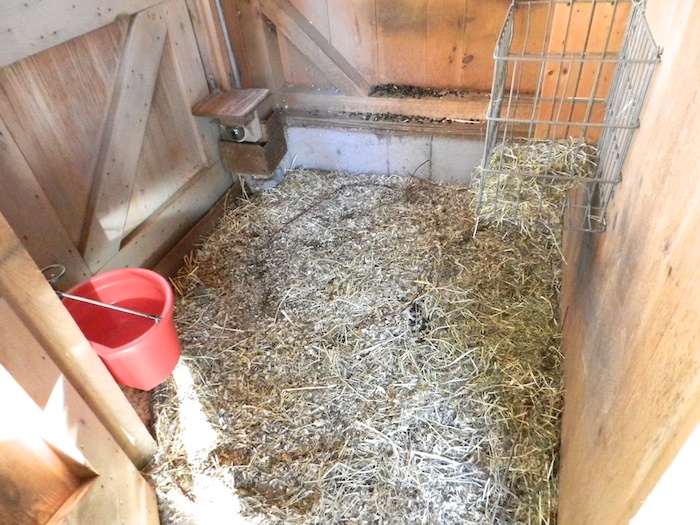
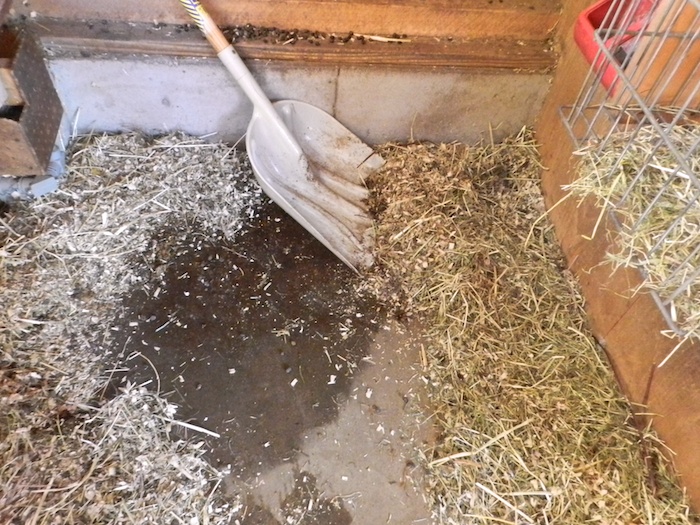


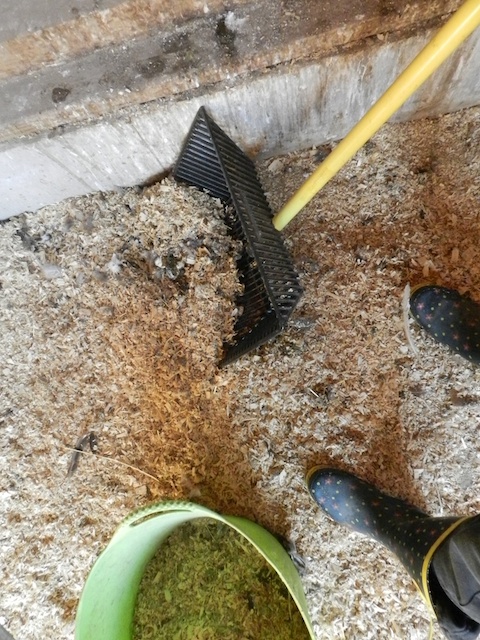
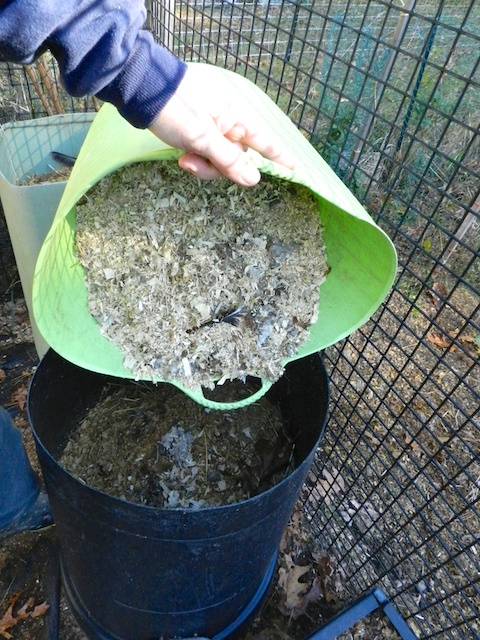


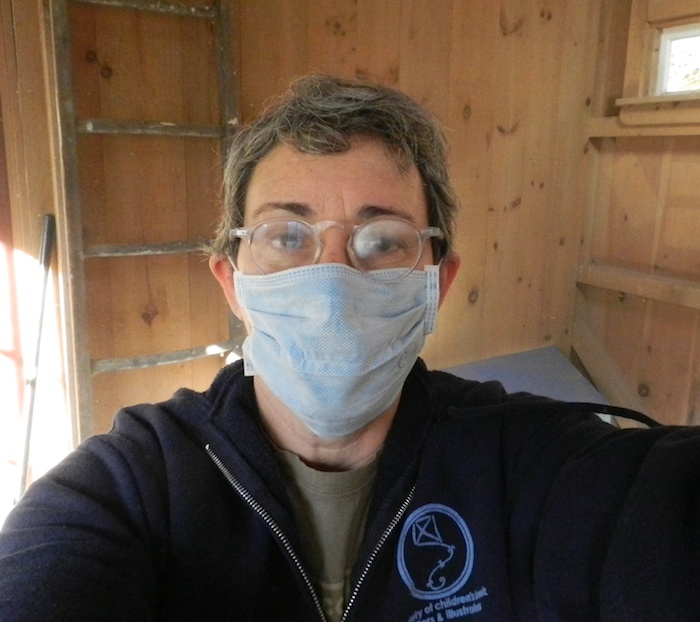

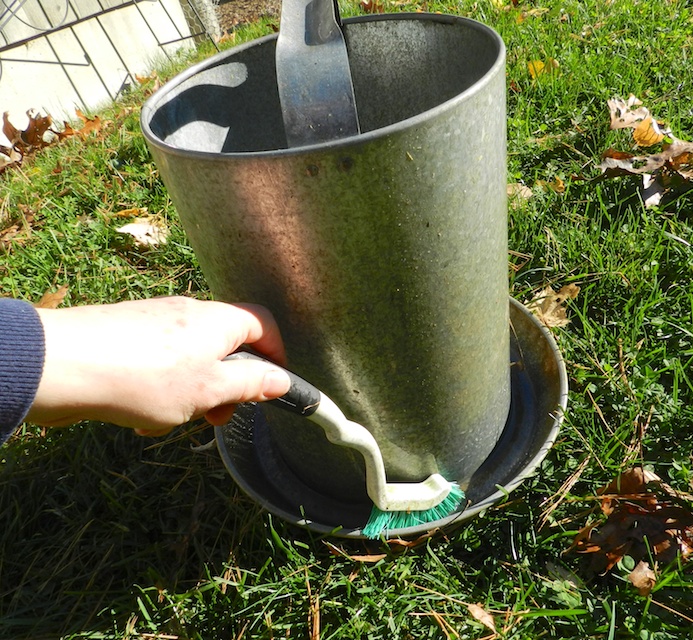

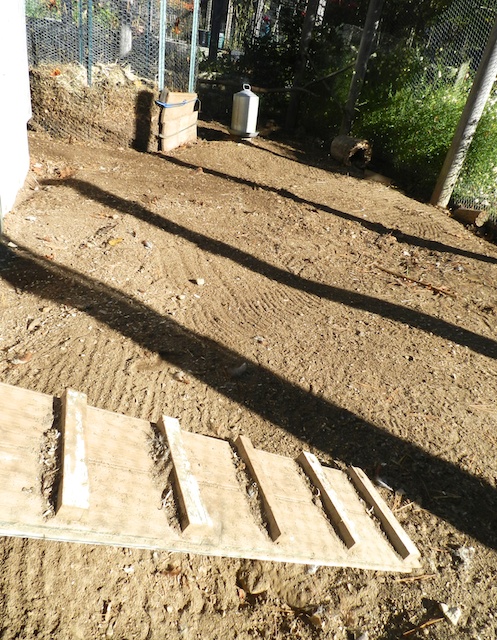



Yup. I’ve tried barn cleaning with goats inside many many times, and it generally ended with me tying them all up as far away from the wheelbarrow as possible. They are a force of nature when there is a wheelbarrow to be had. Like multiple tornados all trying to destroy the same car. o.o
And yet they do it with smiles on their faces :)
I do love a clean hen house good, bad or.indifferant I also mix .some
DE in the shavings and in the nesting boxes. I had mites at one time and this helps
MItes are so hard to get rid of.
I have to invest in a box of those masks, stat. I did a thorough cleaning of our coop yesterday and the dust was overwhelming!! Once I was done, the coop was so clean, I could have slept in there! And where were the girls? Rummaging around in the wheelbarrow full of poop!
So “broody poop” is what it is called! I only had one instance of it so far. I thought the hen had a problem and thought an egg was a-coming.
I have a couple of bedding/litter questions, I’m hoping no one will chastise me on the size of my coop/run or my decisions so far, We are new to this and trying to do our very best in an area that isn’t exactly backyard chicken friendly. I have 6 pullets, about 14 weeks old, 2 black star, 2 red star, 1 easter egger, and 1 rhode island red. We live in a suburb of Salt Lake City, and we don’t have a huge lot; maybe 0.2 acres total.
Our backyard is fully fenced, 3/4 wooden slat, 1/4 chain link (to be replaced come spring). We have built most of the girls’ home out of scraps and re-purposed lumber and crates. Their coop is taller than it is long or wide, the roof is about 7′ tall, the width is about 3.5′ by 3.5′, They have multiple roosts and 2 good size nesting boxes. Obviously the floor of the coop is not huge, maybe 10ish square feet. I open their sliding door into their ‘run’/play area every morning no more than 15 minutes after it starts to get light out, because I know they can’t stay in a small space too long or they may fight with each other. Their play area is at least 10’x10′ and was just expanded to include a 4’x4’x6’ compost/tractor that they have free access to all day long. The girls free range as soon as I know I’m home for good, usually at least from 3pm-7pm during the week and almost all day on the weekends.
my question is this…
I wanted to try to do the deep litter method in the coop, so in the bottom of the coop which is about 7″ above ground on a pallet is a combination of organic soil (a large bag was needed to fill in the 7″ hole, pine shavings, and now about 2 months of chicken poop. I turn it daily so that no wet stuff is left on top, and by now it’s mostly shavings and poop with a bit of soil. Does this sound ok? There is absolutely no smell what-so-ever. The girls have taken to sleeping in one of their nest boxes so I clean it out daily and mix it in.
In their run I have a light layer of pine that I just rake around daily or every other day so that it cuts down on smell, and that I can walk in there to check food and stay somewhat clean.
This is long and I’m so sorry! I just didn’t want to post on a site like backyard chickens and hope for advice, because I know everyone has their own methods… You and the ChickenChick just seem soooo knowledgeable and level headed.
Hi Tessica,
First of all, no one chastises here. This isn’t a forum – it’s just me writing and answering questions and a lot of wonderful people following along. As far as your question – to be very brief I do not believe in the deep litter method for small backyard coops. I’ve been meaning to write a complete post about that. For now, that ‘s all I’ll say in the space here. As far as your setup: multiple roosts and height help when the floor space is below the minimum recommended. Keeping everything clean and dry really helps. In the summer it’s not so bad, but when chickens are confined during inclement weather, then you’ll see problems. If you can’t expand the floor space, you can create “hen solariums” for the girls to hang out in during the day. As far as chickens sleeping in nesting boxes – I discourage that. Do a blog search on my site and you’ll find a number of posts with suggestions of how to break that habit.
Thanks Terry! I was hoping to decide on the litter method while it’s still warm enough to change it! And, if I shovel everything out it would go perfectly in my compost pile! I’d love to shovel out as much as possible and maybe fill the coop flooring with sand so I can just scoop it like we do the cat box? Will this cut down on the possibilities of mites?
I was thinking last night as one girl was roosting and the others were in a box (knowing that the temp would be almost 30 degrees) that I need to get them all roosting as a warm team ASAP. I’ll get those boxes closed off and read your suggestions of breaking that habit!
I’m not a fan of sand floors as I think that they hold onto moisture. Simple dirt floors have issues too, as they are easy for predators and vermin to enter. I prefer a solid floor bedded with shavings.
Terry, I have an idea for Tessica’s coop floor: laying patio/paving stones on top of the existing dirt floor. It will be more predator-secure then, plus it will be easier to clean and she can still use shavings for bedding. She would only need four 2ft x 2ft stones for her coop, so that would be fairly inexpensive, and she’d just need to find a way to cut two of them to fit. What do you think?
Great post, by the way, Terry – thank you again. Chock full of practical information, as always.
Predators can still burrow in. However, a perimeter of a narrow ditch filled with gravel prevents tunnels, so that’s one thing to do.
What a post…I have way too many comments! :-)
First of all, I was thinking about what a perfect combination for composting: high carbon wood shavings + high nitrogen manure.
And it was good to see the routine at Little Pond Farm. I’m taking an introductory animal science course at L.A. Pierce College. For our lab, it’s mostly cleaning up after the hens, sheep and goats, and it’s great experience. Also, I’m trying to see if I can handle the labor that comes with such livestock. One drawback: last time I had a milk chocolate bar, it smelled sort of familiar…sort of like the goats! :-P
Questions- do you purchase the pine shavings from a livestock supply or do you get it from a lumber yard?
Have you ever heard of people making moveable goat barns, so that the ammonia-saturated ground could air out?
Thanks for all the great information! And the photos- those goats are so charming and funny!
Ive deep littered all my chicken houses going back probably 50 years …not sure if they even called it deep littering back then. My farm is all organic, and all their food comes from my gardens, orchards, and fields and litter that goes in my chicken houses and other animals’ pens are organic materials from my property. I don’t have any problems with mites, ammonia smells, and I turn my 10 to 12 inches deep (for winter) bedding often. My bedding for winter is made up of shredded pine that’s collected in my woods and run through the shredder and rye grass straw,. I thoroughly cleaned my chicken houses for winter this past weekend, and after they were completely empty, swept, and windows and screens cleaned, I then used white vinegar in spray bottles and sprayed everywhere. Then, I opened the windows and door open wide to air it all out, then put down the bedding. I also double checked there are no cracks anywhere that would let in cold weather or rodents. Now, they’re all set for winter. All the old bedding went right on one of my garden plots, and I covered it all up with tarps for the winter. My chickens are free range. I let them loose at 6:30, and close them up for the night at 6:30. I don’t use heat lamps (the deep litter keeps the houses warm), and prefer not to use artificial light. If they lay fewer eggs in the winter, due to not enought daylight hours, I figure that’s the natural way it should be. This summer I experimented for 2 months, using sand for bedding for 30 pullets in the pullet house, but I didn’t like using the sand. In fact, at the State Fair, I heard 2 judges tell FFA members not to use sand for bedding. Next weekend, I tackle livestock pens. Work never ends around here.
Hi Joy, some barns, and some flocks do very well on deep litter. Yours is one of them (it sounds like a lovely, and well-cared for farm! I, too, spray with white vinegar.) But, for most people in suburban settings with a small flock, and a coop without appropriate flooring, ventilation, doors, space, etc, it fails. It’s like the difference between a good compost pile and one that sits there and rots.
Terry,
Thoughts on cedar bedding? I’ve read multiple articles on it, some say it’s bad, some say it is not.
It is cheaper here, but more than that I like the smell.
I found that the use of a “poop board” under my roosts has been extremely helpful in keeping the coop clean. My husband made it so that it sits on brackets and can be removed if needed, but all I do every morning is scrape up the droppings with a metal dust pan and discard them into the compost barrel. Thirteen hens produce just one medium size dust pan full of waste each night, and there is practically nothing on the floor!
Has anybody tried leaving a sheet of newspaper down there? But I guess the hens would move it around or tear it up-?
Wing flaps = flying newspaper = freaked out hens.
I was about to say something similar, but you said it better :)
Cedar chips have been known to harbor bacteria that are harmful to chickens. Cedar also gives off fumes that could weaken the chickens’ respiratory systems,leaving them more susceptible to respiratory problems. Cedar should be avoided. I learned this firsthand about 20 years ago. i was hospitalized when a shipment of day old chicks arrived. My family put down cedar chips for the chicks and I lost 11 out of 50 chicks due to respiratory issues. i called a few farmer friends, and we all agreed it must have been the cedar chips.The next year, I was a poultry judge at the county fair, and the man who had the contract for providing bedding for all the poultry there, confirmed what we had decided…the cedar is bad news for chickens. The 2 local feed stores have warning signs in their poultry aisles, telling people not to use the cedar chips on poultry.
I’ve heard the arguments, but never a first-hand account. Thanks for sharing, but sorry that you had to learn the hard way.
My grandmother had about 20 chickens at any given time on her farm. One day she complained that she was tired of cleaning the chicken coop and told my grandfather that he would do it from then on. My grandfather then constructed a hatch door that ran along the entire back wall of her chicken coop. When he went to clean the coop, he unlocked and lifted the hatch door and started up the leaf blower, blowing the floor clean and sending all the debris out into the back field. This was followed by a good scrubbing of whatever needed scrubbing and some fresh bedding, then he waited a couple of hours to let the dust settle before letting the chickens back in.
Clever solution by your grandfather. If only the rest of us had a field to blow manure into :)
I like to throw a handful of Sweet Annie in the coop. Smells so nice!